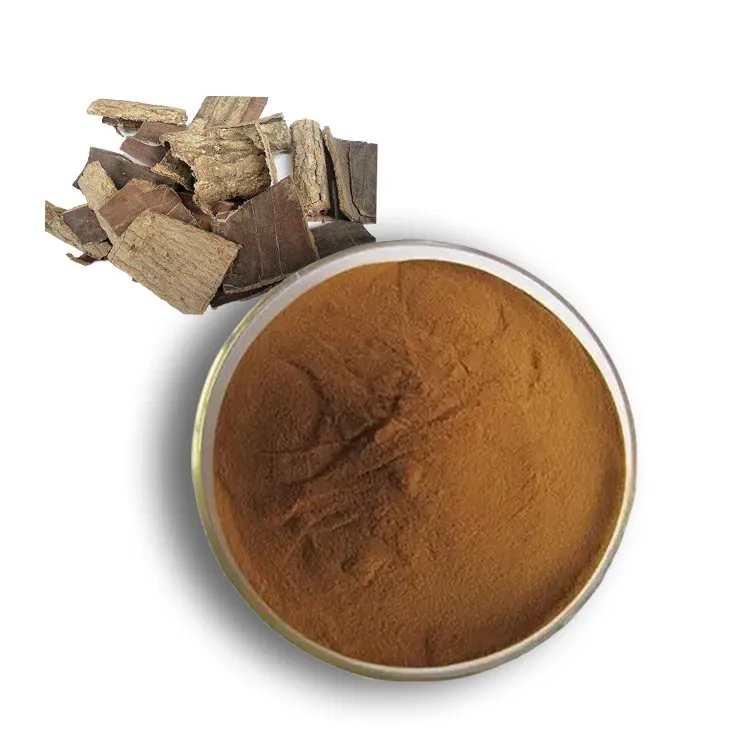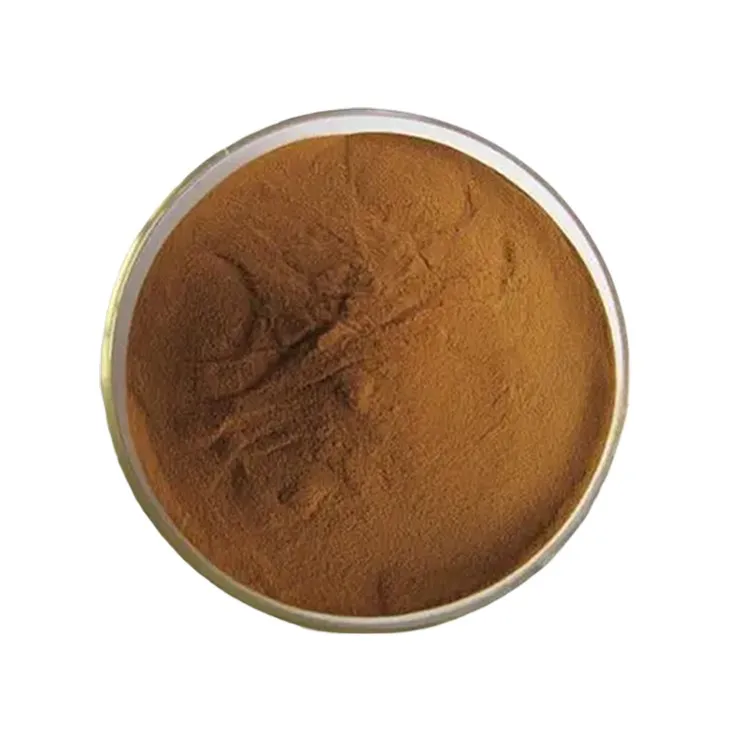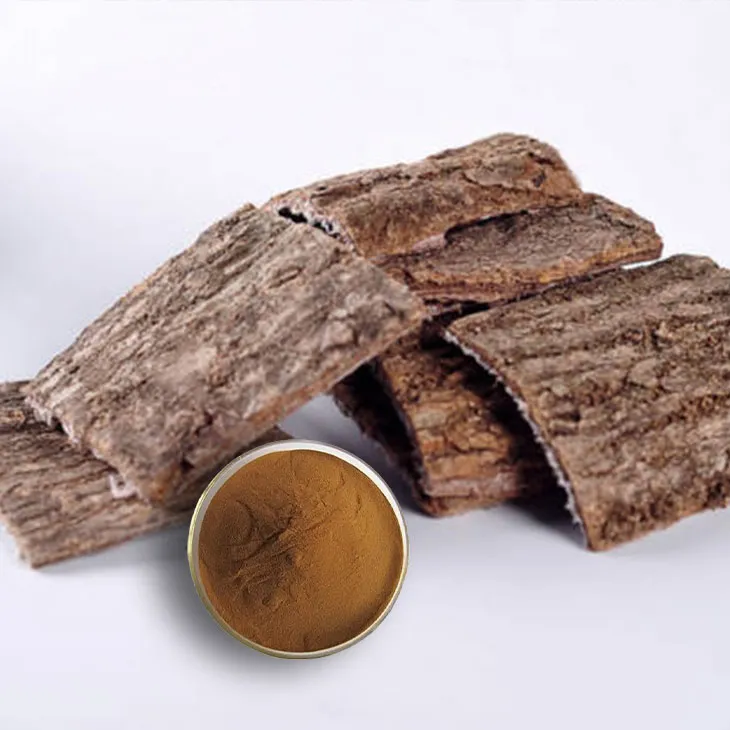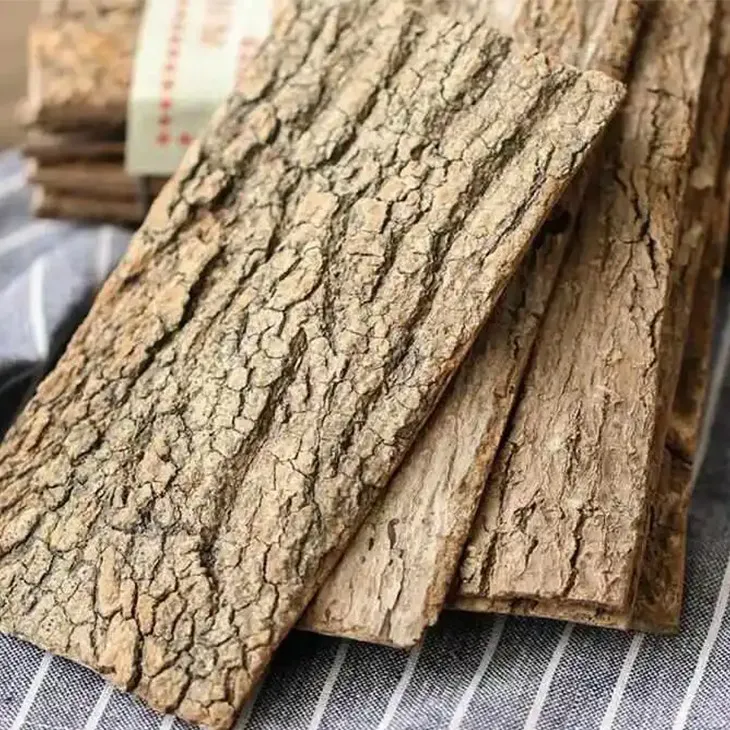- 0086-571-85302990
- sales@greenskybio.com
The process of extracting eucommia ulmoides chlorogenic acid from eucommia ulmoides extract.
2024-11-28

1. Introduction
Eucommia ulmoides is a well - known traditional Chinese medicinal plant, which contains a variety of bioactive compounds. Among them, chlorogenic acid is one of the most important components. Chlorogenic acid has been found to possess a wide range of biological activities, such as antioxidant, anti - inflammatory, antibacterial, and antiviral properties. Therefore, the extraction of chlorogenic acid from Eucommia Ulmoides Extract has attracted significant attention in recent years. This article will focus on the extraction process of chlorogenic acid from Eucommia Ulmoides Extract, including various extraction methods, factors influencing the extraction, and the significance of chlorogenic acid in different fields.

2. Extraction Methods
2.1 Solvent Extraction
Solvent extraction is one of the most commonly used methods for extracting chlorogenic acid from Eucommia Ulmoides Extract. The principle of this method is based on the solubility of chlorogenic acid in different solvents. Generally, polar solvents such as ethanol, methanol, and water are used for extraction.
- Ethanol extraction: Ethanol is a popular solvent for extracting chlorogenic acid. The extraction process usually involves soaking the Eucommia ulmoides extract in ethanol with a certain concentration for a specific period of time. Then, the mixture is filtered to obtain the extract containing chlorogenic acid. The advantage of ethanol extraction is that ethanol is relatively safe, has good solubility for chlorogenic acid, and can be easily removed by evaporation.
- Methanol extraction: Methanol can also be used as a solvent for chlorogenic acid extraction. However, methanol is more toxic than ethanol, so special attention should be paid to safety during the extraction process. The extraction procedure is similar to that of ethanol extraction.
- Water extraction: Water is a green and environmentally friendly solvent. Although the solubility of chlorogenic acid in water is relatively lower than that in ethanol and methanol, it can still be used for extraction. Water extraction usually requires higher extraction temperature and longer extraction time to achieve a satisfactory extraction rate.
2.2 Supercritical Fluid Extraction
Supercritical fluid extraction (SFE) is a relatively new and advanced extraction method. In this method, supercritical fluids, such as supercritical carbon dioxide (sc - CO₂), are used as solvents. The supercritical state of a substance has unique physical and chemical properties, such as high diffusivity and low viscosity.
- The extraction process of supercritical fluid extraction: First, the Eucommia ulmoides extract is placed in the extraction vessel. Then, supercritical carbon dioxide is introduced into the vessel under certain pressure and temperature conditions. Chlorogenic acid in the extract is dissolved in the supercritical carbon dioxide. After that, the supercritical fluid containing chlorogenic acid is separated from the extract by adjusting the pressure and temperature, and chlorogenic acid is finally obtained.
- Advantages of supercritical fluid extraction: Compared with traditional solvent extraction methods, supercritical fluid extraction has several advantages. It is a clean and green extraction method, as supercritical carbon dioxide is non - toxic, non - flammable, and easy to recycle. In addition, supercritical fluid extraction can achieve high extraction efficiency and selectivity, and can effectively avoid the degradation of chlorogenic acid during the extraction process.
2.3 Microwave - Assisted Extraction
Microwave - assisted extraction (MAE) is another effective extraction method. Microwave irradiation can cause the polar molecules in the Eucommia ulmoides extract to generate heat rapidly through dipole rotation and ionic conduction, which promotes the dissolution of chlorogenic acid in the solvent.
- The extraction process of microwave - assisted extraction: The Eucommia ulmoides extract is mixed with the extraction solvent and placed in a microwave - transparent container. Then, the mixture is irradiated with microwaves for a certain time and power. After microwave treatment, the mixture is cooled and filtered to obtain the extract containing chlorogenic acid.
- Advantages of microwave - assisted extraction: Microwave - assisted extraction can significantly shorten the extraction time compared with traditional solvent extraction methods. It also has the advantages of high extraction efficiency and energy - saving. However, improper microwave power and irradiation time may cause the degradation of chlorogenic acid, so appropriate parameters need to be carefully selected.
2.4 Ultrasonic - Assisted Extraction
Ultrasonic - assisted extraction (UAE) utilizes ultrasonic waves to enhance the extraction of chlorogenic acid from Eucommia ulmoides extract. Ultrasonic waves can produce cavitation effects in the solvent, which can break the cell walls of the plant material and promote the release of chlorogenic acid into the solvent.
- The extraction process of ultrasonic - assisted extraction: The Eucommia ulmoides extract is combined with the extraction solvent, and then ultrasonic waves are applied to the mixture for a certain time and frequency. After ultrasonic treatment, the mixture is filtered to obtain the extract containing chlorogenic acid.
- Advantages of ultrasonic - assisted extraction: Ultrasonic - assisted extraction is a simple, efficient, and environmentally friendly extraction method. It can improve the extraction efficiency of chlorogenic acid, reduce the extraction time and solvent consumption, and has little impact on the quality of chlorogenic acid.

3. Factors Influencing the Extraction
3.1 Solvent Type and Concentration
As mentioned above, different solvents have different solubilities for chlorogenic acid. The choice of solvent type and concentration has a significant impact on the extraction efficiency. For example, in solvent extraction, a higher concentration of ethanol may lead to a higher extraction rate of chlorogenic acid within a certain range. However, if the concentration is too high, it may also cause the co - extraction of other impurities, which will affect the purity of the final product.
3.2 Extraction Time
The extraction time also plays an important role in the extraction of chlorogenic acid. Generally, as the extraction time increases, the extraction amount of chlorogenic acid will gradually increase. However, when the extraction time reaches a certain value, the extraction amount will no longer increase significantly, or may even decrease due to the degradation of chlorogenic acid. Therefore, it is necessary to optimize the extraction time according to different extraction methods.
3.3 Extraction Temperature
Extraction temperature affects the solubility of chlorogenic acid in the solvent and the rate of chemical reactions. In solvent extraction, increasing the extraction temperature can usually improve the solubility of chlorogenic acid, thereby increasing the extraction efficiency. However, for some heat - sensitive substances like chlorogenic acid, too high a temperature may cause its degradation. In supercritical fluid extraction, the extraction temperature also needs to be carefully controlled to ensure the supercritical state of the fluid and the stability of chlorogenic acid.
3.4 Particle Size of Eucommia ulmoides Extract
The particle size of Eucommia ulmoides extract has an impact on the extraction process. Smaller particle sizes can increase the contact area between the extract and the solvent, which is conducive to the extraction of chlorogenic acid. Therefore, grinding the Eucommia ulmoides extract to an appropriate particle size before extraction can improve the extraction efficiency.

4. Significance of Chlorogenic Acid in Multiple Fields
4.1 Pharmaceutical Field
In the pharmaceutical field, chlorogenic acid has shown great potential. Its antioxidant and anti - inflammatory properties make it a candidate for the treatment of various diseases. For example, it may be used in the treatment of cardiovascular diseases, as it can reduce oxidative stress and inflammation in the blood vessels. It may also have potential applications in the treatment of diabetes, as it can regulate blood glucose levels.
4.2 Food Industry
In the food industry, chlorogenic acid can be used as a natural antioxidant to extend the shelf life of food products. It can also be added to functional foods as a health - promoting ingredient. For example, in coffee, chlorogenic acid is one of the main bioactive components, which gives coffee certain health - promoting effects.
4.3 Cosmetic Industry
In the cosmetic industry, chlorogenic acid can be used in skin care products due to its antioxidant and anti - inflammatory properties. It can help to protect the skin from oxidative damage, reduce skin inflammation, and improve skin health.

5. Conclusion
In conclusion, the extraction of chlorogenic acid from Eucommia ulmoides extract is a complex but important process. Different extraction methods, such as solvent extraction, supercritical fluid extraction, microwave - assisted extraction, and ultrasonic - assisted extraction, each have their own advantages and limitations. The extraction efficiency is influenced by factors such as solvent type and concentration, extraction time, extraction temperature, and particle size of the extract. Chlorogenic acid has significant value in multiple fields, including the pharmaceutical, food, and cosmetic industries. Future research should focus on further optimizing the extraction process to improve the extraction efficiency and purity of chlorogenic acid, and exploring more potential applications of chlorogenic acid in different fields.
FAQ:
Q1: What are the common methods for extracting chlorogenic acid from Eucommia ulmoides extract?
There are several common methods for extracting chlorogenic acid from Eucommia ulmoides extract. One of the frequently used methods is solvent extraction. Organic solvents such as ethanol are often employed. Another method is ultrasonic - assisted extraction, which can enhance the extraction efficiency by using ultrasonic waves to break cell walls and improve mass transfer. Supercritical fluid extraction is also an option, with carbon dioxide being a common supercritical fluid, which offers advantages such as being non - toxic and having good selectivity.
Q2: What factors can influence the extraction of chlorogenic acid from Eucommia ulmoides extract?
Several factors can influence the extraction. The type of solvent used is crucial. Different solvents have different solubilities for chlorogenic acid. The extraction time also plays a role. Longer extraction times may increase the yield up to a certain point, but may also lead to the extraction of unwanted compounds. Temperature is another factor. Higher temperatures can generally increase the solubility of chlorogenic acid, but excessive heat may cause degradation. The particle size of the Eucommia ulmoides extract also matters. Smaller particle sizes usually result in a larger surface area, facilitating better extraction.
Q3: Why is chlorogenic acid from Eucommia ulmoides extract significant in the medical field?
Chlorogenic acid from Eucommia ulmoides extract has several important implications in the medical field. It has antioxidant properties, which can help combat oxidative stress in the body. This may be beneficial in preventing various diseases associated with oxidative damage, such as some cardiovascular diseases. It also has anti - inflammatory effects, which can be useful in reducing inflammation in the body, potentially alleviating symptoms in inflammatory conditions like arthritis. Additionally, it may have antibacterial and antiviral activities, which can contribute to fighting infections.
Q4: How can the purity of chlorogenic acid extracted from Eucommia ulmoides extract be determined?
There are multiple ways to determine the purity of chlorogenic acid extracted from Eucommia ulmoides extract. High - performance liquid chromatography (HPLC) is a commonly used method. It can separate and quantify chlorogenic acid based on its chemical properties and retention time in a chromatographic column. Spectrophotometric methods can also be used. By measuring the absorbance of the extract at a specific wavelength corresponding to chlorogenic acid, an estimate of its concentration and purity can be made. Additionally, mass spectrometry can provide detailed information about the molecular mass and structure of chlorogenic acid, which is useful for assessing its purity.
Q5: What are the applications of chlorogenic acid from Eucommia ulmoides extract in the food industry?
In the food industry, chlorogenic acid from Eucommia ulmoides extract has various applications. It can be used as a natural antioxidant to prevent food spoilage caused by oxidation. This helps in extending the shelf - life of food products. It may also be added to functional foods due to its potential health - promoting properties, such as its antioxidant and anti - inflammatory effects. Some beverages may also contain chlorogenic acid as an ingredient for its unique flavor and potential health benefits.
Related literature
- Extraction and Characterization of Chlorogenic Acid from Eucommia ulmoides Oliv. Bark"
- "Optimization of Chlorogenic Acid Extraction from Eucommia ulmoides by Response Surface Methodology"
- "Study on the Pharmacological Activities of Chlorogenic Acid from Eucommia ulmoides"
- ▶ Hesperidin
- ▶ Citrus Bioflavonoids
- ▶ Plant Extract
- ▶ lycopene
- ▶ Diosmin
- ▶ Grape seed extract
- ▶ Sea buckthorn Juice Powder
- ▶ Fruit Juice Powder
- ▶ Hops Extract
- ▶ Artichoke Extract
- ▶ Mushroom extract
- ▶ Astaxanthin
- ▶ Green Tea Extract
- ▶ Curcumin
- ▶ Horse Chestnut Extract
- ▶ Other Product
- ▶ Boswellia Serrata Extract
- ▶ Resveratrol
- ▶ Marigold Extract
- ▶ Grape Leaf Extract
- ▶ New Product
- ▶ Aminolevulinic acid
- ▶ Cranberry Extract
- ▶ Red Yeast Rice
- ▶ Red Wine Extract
-
Pomegranate Extract
2024-11-28
-
Mango flavored powder
2024-11-28
-
White Willow Bark Extract
2024-11-28
-
Nettle Root Extract
2024-11-28
-
Dandelion Leaf Extract
2024-11-28
-
Maitake Mushroom Extract
2024-11-28
-
Rosemary extract
2024-11-28
-
Coconut Water Powder
2024-11-28
-
Bamboo Leaf extract
2024-11-28
-
Acerola Extract
2024-11-28





















